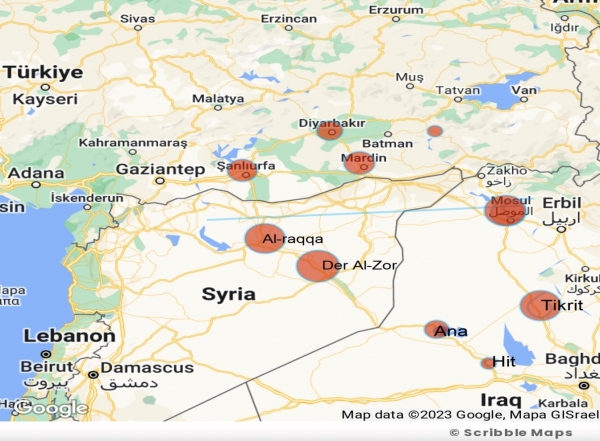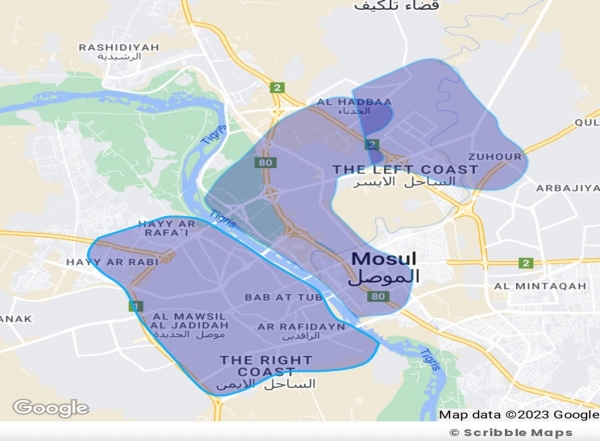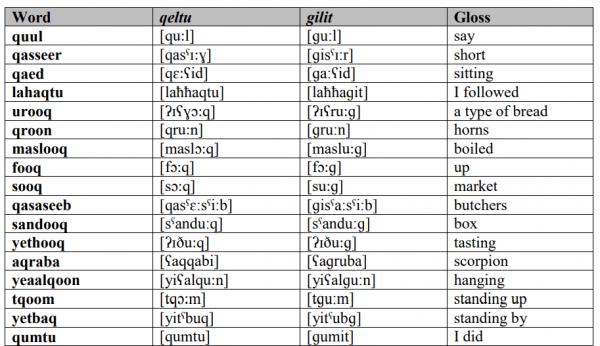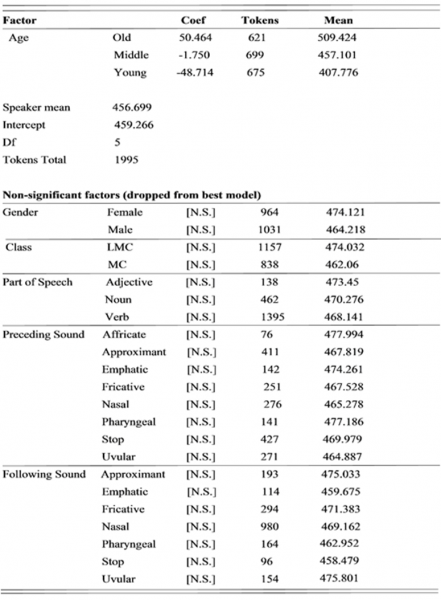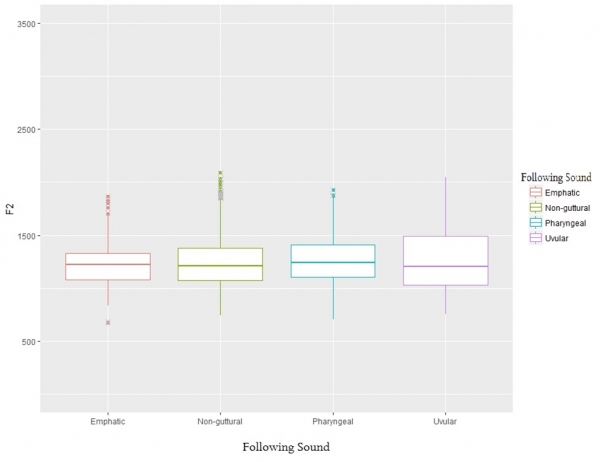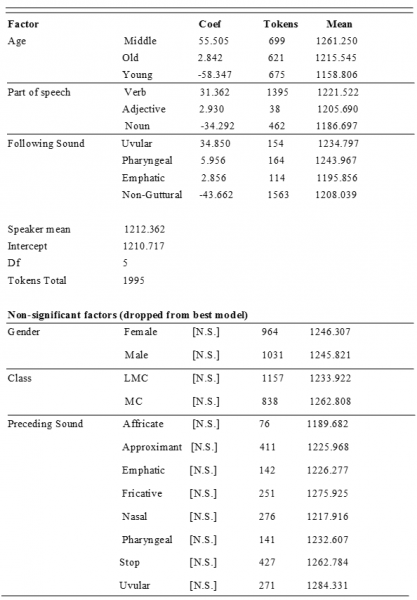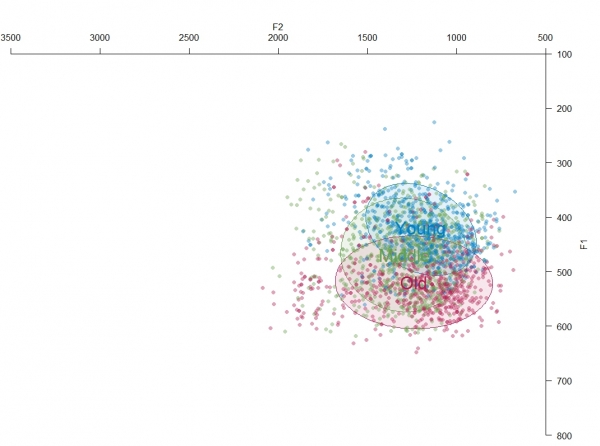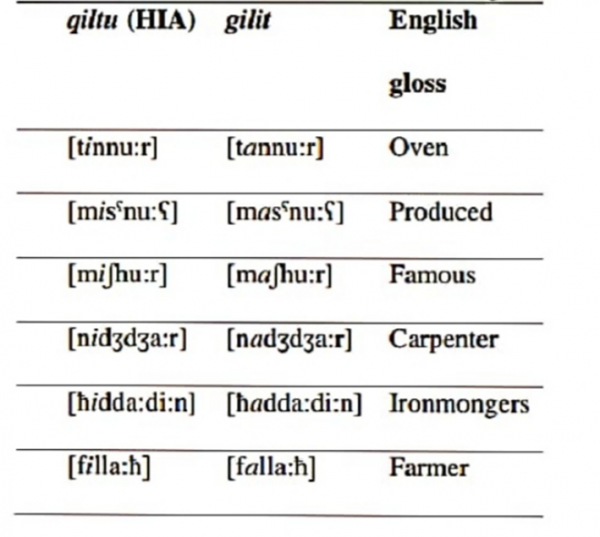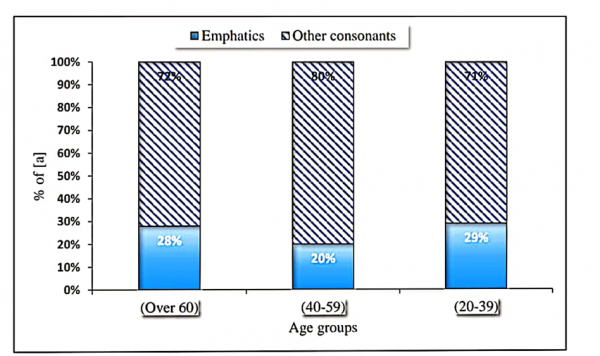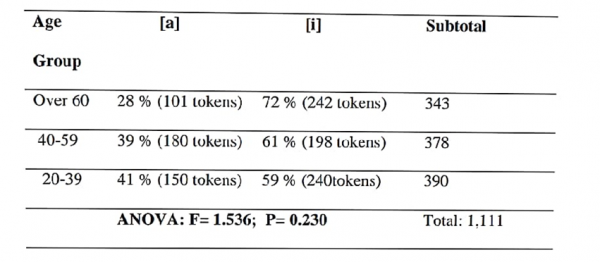Thinking outside the guttural box: fresh perspectives on vowel lowering in Qeltu L’abaissement vocalique en Qeltu : une approche sociophonétique
This study revisits the process of vowel lowering in the Arabic dialect known as Qeltu, which is spoken in parts of northern Iraq and neighboring Syria and Turkey. It aims to uncover hitherto unreported patterns of vowel lowering and re-examines a frequently held axiom that attributes a categorical impact of specific linguistic units on the behavior of this phonological process (e.g. Al-Ani, 1970; Thelwall, 1990; Rose, 1996). The analysis of spoken data from 30 speakers considers various linguistic and social constraints that may or may not influence the process of vowel lowering. The data was collected through sociolinguistic interviews (Tagliamonte, 2006). It is generally acknowledged that the main allophones of Iraqi Arabic [i], [iː], [uː] (Al-Khalesi, 2006) are respectively realized as [a], [ɛː], and [ɔː] in Qeltu (Jastrow, 1994 & 2006). This is especially noticeable when these vowels are adjacent to guttural sounds, as exemplified in the words: /miʃhuːr/ famous, /sˤtˤuːħ/ roof and /daqiːq/ flour, which are pronounced as [maʃhɔːr], [sˤtˤɔ:ħ] and [daqɛ:q], respectively (Jastrow, 1994; Muhammad, 2018). Results indicate that the relationship between guttural sounds and the lowering of vowels in Qeltu cannot be solely predicted by their proximity to each other, and that additional social factors are involved in determining this phenomenon.
La présente étude traite du processus d’abaissement vocalique en Qeltu, une variété d’arabe, parlée dans le nord de l’Irak ainsi qu’en Syrie et en Turquie. Elle explore le fonctionnement de ce processus phonologique, visant à aller au-delà des explications communément associées à cette variété qui s’appuient exclusivement sur des considérations linguistiques (cf. e.g. Al-Ani, 1970 ; Thelwall, 1990 ; Rose, 1996). Les analyses se basent sur un corpus de parole spontanée de 30 locuteurs (selon la méthode des entretiens en sociolinguistique, Tagliamonte, 2006) et prennent en compte des facteurs tant linguistiques que socio-linguistiques susceptibles d’être corrélés à l’abaissement vocalique. Al-Khalesi (2006) indique que les allophones de l’arabe iraquien [i], [iː], [uː] sont réalisées respectivement [a], [ɛː], et [ɔː] en Qeltu (Jastrow, 1994 & 2006), surtout lorsque les voyelles sont précédées d’une consonne gutturale : /miʃhuːr/ connu, /sˤtˤuːħ/ toit et /daqiːq/ farine, seraient prononcés [maʃhɔːr], [sˤtˤɔ:ħ] et [daqɛ:q] (Jastrow, 1994 ; Muhammad, 2018). Cependant, les résultats de cette étude montrent que la proximité avec une gutturale ne suffit pas à rendre compte de ce phénomène d’abaissement et que des facteurs sociolinguistiques jouent un rôle majeur.
1. Vowel lowering: an overview
1Vowel lowering is a process that involves a change in the height of vowel sounds within the vowel space. This change typically results in vowels being produced at a lower position in the space than they are otherwise. This phenomenon has been observed in a wide range of languages across the world, indicating its widespread occurrence and importance in phonology (Rose, 1996). English is one of the languages that display this phenomenon. Hickey (2018) describes varieties of English with lowering of short front vowels, i.e. bet for bit, dack for deck (Canadian, Californian and Dublin Englishes). Previous research (e.g. Labov, 1986; Hoffman, 2010; Eckert, 2012; Hickey, 2003) focusing on the English language has shown that the process of vowel shifting can have social or cultural implications beyond purely linguistic aspects. For instance, this phenomenon may be used by speakers to establish a sense of affiliation or dissociation with a particular group or community (Housholder, 1983; Rakić et al., 2011). This suggests that vowel lowering may not solely be a linguistic phenomenon, but also a sociolinguistic marker pointing at ways in which language is used in various social contexts.
2Vowel lowering has also been observed in certain varieties of Arabic. However, Alshammari (2019) indicates that they have been predominantly studied either through a phonological lens (e.g. Rose, 1996) or a phonetic one (e.g Al-Ani, 1970, p. 34). Other studies have honed in on pharyngeal coarticulation and determined the patterns and mechanisms involved in vowel lowering in Arabic. These include Ali & Daniloff (1972), McCarthy (1994), Altairi et al. (2017) and Al-Ansari & Kulikov (2023). These studies, while considered essential contributions to the study of Arabic linguistics, are more theory-driven than data-driven. Indeed, the amount of linguistic data used in these studies is relatively limited. Nonetheless, these investigations represent an important starting point for further exploration and understanding of vowel lowering and other phonological features in Arabic.
2. The Qeltu variety
2.1. Geographic location
- Note de bas de page 1 :
-
The maps were created by the author using Google Maps and Microsoft paint software as an editor.
3Qeltu is a dialect of Arabic spoken in a region commonly referred to as northern Mesopotamia. This area encompasses a vast expanse that spans northern Iraq and the parts around the conterminous borders with Syria and Turkey. In the current study, which focuses on the Iraqi part, Qeltu is found predominantly in towns situated along the Tigris and Euphrates rivers. Accordingly, in Jastrow’s (2006b) trichotomous classification of the Qeltu dialects, three distinct subgroups are identified: Tigris, Euphrates, and Anatolian. The Euphrates group of Qeltu dialects extends along the Euphrates basin, encompassing towns situated along the Euphrates River, including locations like Hit and Ana (as illustrated1 in Figure 1).
Figure 1: Qeltu-speaking area (North Mesopotamia)
2.2. The two Qeltu varieties analysed in this study
4The aim of this paper is twofold: to present new findings on vowel lowering in two urban Qeltu dialects using the author’s dataset to shed light on the variation within this process. The first dialect is spoken in the city of Mosul, Iraq, Iraq’s third largest city. Regardless of their religion or ethnicity, all participants of the study are native Maṣlāwī (i.e. native of Mosul) and speak Qeltu. The use of Qeltu in Mosul and Baghdad differs in that Qeltu is spoken according to religious affiliation in Baghdad, with Jews and Christians using it while Muslims speak Gilit (Blanc, 1964). The Qeltu dialect spoken in Mosul belongs to the Tigris group of Qeltu dialects. This classification is based on the fact that Mosul is one of the towns located along the Tigris river. The other Qeltu dialect considered in this study is Hiti Arabic (henceforth HA). This dialect is spoken in the town of Hit, which is situated around 180 km to the west of Baghdad on the Euphrates river. The dialect of Hit belongs to the Euphrates group of Qeltu dialects.
2.3. Phonetic specificity of Qeltu: vowel lowering
5Qeltu-speaking communities tend to lower their articulation of /uː/ to [oː] as in /suːq/ → [soːq] ‘market’. Vowel lowering is a well-documented aspect of the Anatolian Qeltu Arabic dialects, which are spoken in the Anatolian region of Turkey. A number of studies have reported this phenomenon–Lahdo (2009) focuses on the Tillo dialect spoken in the Siirt province of Turkey. The fundamental rule governing vowel lowering is that when an emphatic consonant or any of the consonants /x/, /ɣ/, /q/, /ɦ/, /ʕ/ is adjacent to the vowels /iː/ and /uː/, the vowels undergo a process of lowering, resulting in their pronunciation as [eː] and [oː] respectively. This can be illustrated in the example of the words /maluːɦ/ (good-looking) in which the vowel is lowered resulting in [maloːɦ]. Jastrow (2006a) identified a similar pattern of vowel lowering in the Anatolian Arabic of Kinderib where the word for flour is pronounced as [daqeːq] instead of the standard /daqiːq/. Jastrow attributes the occurrence of lowering in the dialect to the influence of emphatic consonants.
6The spoken form of Qeltu in Iraq has also been found to exhibit vowel lowering. In Iraqi Arabic, Erwin (1963, p. 24) indicates that the pronunciation of vowels such as /uː/ is influenced by the presence of neighbouring emphatic sounds. When the vowel comes in a context contiguous to any of these sounds, it is usually realized as a back, close, and long vowel, with a small variation in pronunciation. Conversely, when the vowel is situated near non-emphatic sounds, it may be pronounced differently. While lowering is a defining feature of Qeltu, Blanc (1964, p. 41) notes that he could not find it in certain verbs such as [asuːq] and [abuːq], which mean ‘I drive’ and ‘I steal’, respectively. Likewise, the aggregate of studies only briefly reported this phenomenon in Qeltu without assessing it with a thorough analysis. Oussani (1901, p. 101) made the first mention of this phenomenon citing it in the speech of Baghdadi Christians as an outcome induced by, albeit rather tenuously, contiguous guttural consonants. This statement gained traction in subsequent accounts (e.g. Blanc, 1964; Jastrow, 1994, 2006b) who have observed that /uː/ and /iː/ are realized as [oː] and [eː] correspondingly in guttural contexts, as in the words [xjoːt] threads and [daqeːq] flour (Jastrow, 2006a, p. 417), as against their standard Gilit forms of [xjoːt] and [daqiːq] respectively. Abu Haidar (1991, p. 18) notes that lowered articulations are more frequently produced in Christian Baghdadi Qeltu than in the Jewish Baghdadi one. Talay (2011, p. 913) reports this type of lowering in the speech of Jews in the northern part of Iraq. The purpose of this study is to further investigate this phenomenon considering two different Qeltu varieties of Arabic.
3. Dataset & Method
3.1 Selection of informants and recording protocol
7The Mosul data comes from recordings of informal conversations of 30 participants. Each age cohort had five speakers, distributed evenly across gender categories. The entire sample consisted of 15 individuals from the Middle Class and 15 from the Lower Middle Class. Establishing a reliable social classification proved to be both theoretically and methodologically challenging due to the scarcity of published information on social classifications in Mosul, compounded by the evolving societal landscape. However, as Watt (1998, p. 98) highlights, the knowledge possessed by insiders of the community, whether they are ordinary residents or researchers, can serve as a highly dependable indicator of existing class distinctions within the community. Therefore, the participants recruited for this study were classified based on their respective neighbourhoods, as these emerged as the most reliable indicators for categorizing Mosul residents in terms of their social class. This approach was further informed by insight provided by the informants who possess intimate knowledge of these areas. As a result, each speaker’s categorization was confirmed by the speakers themselves, who self-identified as either lower middle-class or middle-class according to the neighbourhood in which they lived. The neighborhoods on the left coast (Figure 2) were identified as middle class while those on the right coast were identified as lower middle class.
Figure 2: Qeltu-speaking areas inside Mosul (on both the Right & Left coasts)
8The recordings for this study were conducted within the participants’ residences. In order to create a noise-free environment, small rooms furnished with items such as curtains to minimize acoustic reverberations were used for the recording sessions. Digital recording was used with a sampling rate of 44.1 kHz and a 16-bit resolution, using a portable Edirol R-09HR High-Resolution recorder and an Edirol CS-50 condenser microphone placed on a desk in front of the participants. Before engaging in the study, every participant signed informed consent, confirming their understanding of the scope of their participation. The duration of the sessions varied among speakers, although it was ensured that each session lasted approximately one hour or slightly longer, provided that the speakers were comfortable with the interview and the topics under discussion. Following the approach outlined by Tagliamonte (2006, p. 39), the questions were adapted to include the informants’ preferences in conversation topics, thus enabling a smooth transition between a variety of topics ranging from general questions to more personal themes. This contributed to creating a controlled but accommodating environment for the participants so as to limit the observer effect (Labov, 1981).
3.2. Targeted tokens
9Around 30 hours of natural speech comprised the dataset, from which tokens were extracted and coded for subsequent analysis. In line with Wolfram (1993, p. 214), the number of tokens has been limited to a maximum of 3 per participant to ensure that the dataset includes a wide range of lexical elements and avoids repetitive or overly common items. As such, a total of (1995) lexical items were included in the analysis. Table 1 below gives a sample of tokens coded for analysis.
Table 1: Sample of words retrieved for analysis
3.3 Data Analysis
10Each lexical item was coded according to the predictors selected in this study. The coding of the tokens was done taking into consideration approaches found in previous studies and the objectives of the current study. The tokens were coded for three factors: the part of speech, the preceding sounds and the following sounds. The aim of this assessment was to determine the extent to which the vowel was lowered. The values of the first two formants were measured precisely at the midpoint of each token. This was done to avoid potential influence from adjacent segments (Klatt and Klatt, 1990, p. 829; Thomas, 2010, p. 148). The acoustic measures were extracted through the open-source software ‘Praat’ (Boersma & Weenink, 2017). A Praat script was used to segment and annotate all the coded tokens (García, 2017). During this procedure, both sound and visual cues were used to help determine the beginning and end points of each targeted vowel segment, taking into account the guidelines outlined by Thomas (2010) regarding where to place the boundaries between the adjacent sounds that surround the vowel. After completing the segmentation, all tokens were manually inspected. Approximately 30% of the segmented data underwent a secondary review conducted by a second rater who is trained in phonetics and speaks Arabic. The rater validated 96% of the measurements and suggested alterations for the remaining 4%. Subsequently, a meeting was convened with both raters to reach a consensus on the positioning of boundaries. Labov’s Telsur method was used to normalise the vowel formant data, and this process was carried out using the online resource NORM Suite (Thomas et al., 2007). Labov’s Telsur method is a revised version of Nearey’s method and has proven to be more effective than other methods tested in terms of producing accurate data without distortions and preserving the sociolinguistic variation. Telsur uses the log mean to normalize the formant values, which allows for consistent comparisons across speakers, and then calculates a single grand mean to represent the speech characteristics of the entire group under study. This method has been shown to be highly reliable and useful in sociolinguistic research. A statistical analysis was then carried out to determine the frequency and distribution of the responses (F1 & F2) across the various parameters (i.e. social and linguistic predictors) that were hypothesized to have an impact on them. The goal was to assess the interplay between the parameters and the responses and determine the significance of any observed patterns.
4. Results
4.1. Results of vowel lowering in Mosul
- Note de bas de page 2 :
-
Rbrul, also known by the name “brul,” functions as an R package utilized for the analysis of linguistic data, with a particular focus on the disciplines of linguistics and sociolinguistics. Its primary design is aimed at streamlining the examination of language variation and the dynamics of language evolution through the utilization of mixed-effect modelling techniques. Researchers employ Rbrul to investigate linguistic phenomena, including but not limited to phonological or syntactic shifts, while also scrutinizing the impact of various factors on patterns of language usage. Johnson (2009) reasons that the prevailing edition, GoldVarb, which is widely used, exhibits limited adaptability and, furthermore, separates its users from the broader community of quantitative linguists. Rbrul, being a fresher version of the variable rule software, seeks to tackle these issues.
11The data was analysed using Rbrul2 (Johnson, 2009). A mixed-effect step-wise regression analysis was carried out to evaluate the impact of different factors (social and phonetic) on vowel lowering. A model was designed in which all the contexts discussed above were included as fixed predictors. In this model, speaker and lexical item were retained as random effects. Formant values (F1 then F2) serve as the dependent variable. The Rbrul runs conducted for the first formant are displayed in Table 2 below. The table contains a list of the significant and non-significant predictors that emerged from the step-down model. Related values are listed for each predictor. These include the linear coefficients, the number of lexical items coded and the F1 mean value. The data presented in the table reveals that only age emerged as a significant factor impacting vowel height. Indeed, younger and middle-aged speakers exhibit a tendency towards using variants of this vowel that are higher in quality when compared to the group of older speakers. This is evidenced by the contrasting negative coefficients and mean values observed in these two groups, as opposed to the older group, the coefficient of which was positive and the mean formant value was greater. Evidently, this underscores the dynamic shift in the height of this vowel over time.
12It is also evident from the results that the height of /uː/ is not significantly conditioned by the sound that follows or precedes it. This shows that there is no favourable context (e.g. guttural) for the lowered rendition of /uː/ as has been suggested by previous accounts.
Table 2: Rbrul results for F1 in /uː/. Mixed-effect effect model with F1 (Hz) as y-variable and linguistic factors as x-variable. Random effects: speaker & lexical item
13The boxplots in Figure 3 demonstrate the variability of F1 in relation to the phonological context. The height of the vowel /uː/ does not seem to be determined exclusively by a particular context, as there are no discernible differences between the spread of boxplots. Despite the fact that this vowel’s realization is said to be lower next to pharyngeal contexts, this was not found to be statistically significant. The boxplots of the contexts coded in the model seem to be fairly comparable, with no marked differences between them.
Figure 3: Boxplots of F1 (Hz) in /u:/ according to the predictor of following sound
14Table 3 displays the Rbrul runs for F2 as a dependent variable. It illustrates the advancement dimension of this vowel which suggests that there is a change in apparent time (i.e. across age-groups) as indicated by a statistically significant difference observed between the younger cohort and the middle-aged and elderly groups. The younger speakers, in particular, demonstrate a tendency towards a more back quality of the vowel (lower F2 compared to the other age groups), as indicated by a negative coefficient (-58.347), in contrast to the positive coefficients observed among the middle-aged and elderly groups.
15The table also reveals that the vowel is fronted when preceded by guttural sounds (pharyngeals, uvulars, and emphatics). This stands in contrast to its pronunciation adjacent to non-guttural sounds. However, it is unexpected to encounter a rise in the F2 value, given the retraction of the tongue root and dorsum during the production of these sounds which commonly influences the surrounding vowels (Shahin, 2002). Moreover, the impact of these sounds on adjacent vowels depends on both the type of vowel and the particular dialect under investigation. When the vowel /uː/ is articulated adjacent to a guttural sound, such as a pharyngeal, the tongue’s posture shifts downward and forward, leading to noticeable increases in F1 and F2 values. Consequently, this vowel tends to be pronounced as lowered and centralised (Vaissière, 2011, p. 10). The results of this study align with a number of previous investigations. Al-Ani (1976), in his examination of the influence of pharyngeal sounds on the formants of neighbouring vowels in Iraqi Arabic, assessed the pharyngeal sound /ʕ/ and noted its tendency to raise the second formant of the /u/ vowel while lowering it for /a/. Similar observations have also been documented by Butcher and Ahmad (1987) in the context of Iraqi Arabic and by Alwan (1986) in various Arabic dialects, including Iraqi Arabic.
16This research has also demonstrated that the fronted variant of this vowel is more often pronounced in verbs and adjectives compared to nouns. Although there is a scarcity of prior investigations available for comparative analysis, the sole plausible explanation for this phenomenon might be associated with it being an artefact of the dataset of this study. Consequently, any generalization must be approached with caution. Further research is imperative to elucidate the underlying nature of this observed pattern. Moreover, any form of labialisation will result in a general lowering of formant values (cf. Fant, 1960 and illustrated in Vaissière, 2009).
Table 3: Rbrul results for F1 of /uː/. Mixed-effect model with F1 (Hz) as y-variable and social & linguistic factors as x-variable. Random effects: speaker & lexical item
17Examining the combined F1 and F2 patterns reveals a distinct preference among young speakers for a vowel realization characterized by increased height and retraction, akin to a Gilit-like quality. Figure 4 below illustrates this comprehensive shift in vowel articulation, showcasing both F1 and F2 measurements to map out the articulatory patterns within the vocalic space. A noticeable tendency among young speakers is evident, as their realizations tend to cluster towards a higher and more retracted position on the plot. Conversely, the plot highlights that the articulations of the middle-aged cohorts tend to cluster at a lower position compared to the younger group. Notably, there is a more pronounced distinction between the young and elderly groups, with the latter’s productions occupying a lower position on the plot.
Figure 4: A vowel plot illustrating the behaviour of /uː/ according to the age groups incorporated in the study
18Thus, what appears to be at stake in the behaviour of this vowel is its sociolinguistic dimension, with the linguistic aspect showing no significant impact, as indicated by statistical measurements.
19As regards /iː/ lowering, through the analysis of the data, it was found that this vowel was produced as /iː/ rather than the often-reported lowered form (i.e. /eː/) almost systematically. Only one token was found to be realized with the lowered version of this vowel [ʕaqeːq] ‘agate’. This was found in the speech of a +60 male speaker. This almost systematic patterning found amongst the participants suggests that this phenomenon has undergone change and is nearing completion.
20Moreover, a further exploration of the data revealed that lowering of /uː/ is observed in a wider range of verb types than previously noted in the literature (Blanc, 1964). As such, its occurrence cannot be restricted to the verb conjugations reported by Blanc (1964, p. 41) i.e. [asuːq] ‘I drive’ and [abuːq] ‘I steal’, traditionally pronounced [asoːq] and [aboːq] in Qeltu.
21It can also be noted that lowered articulation of /uː/, i.e. [oː] can actually occur in contexts other than those of gutturals. This also stands in contrast to previous accounts (e.g. Jastrow, 1994; Oussani, 1901). In fact, the data revealed that lowered productions of /uː/ can occur across the board in terms of neighbouring segments even in entirely guttural-free tokens as can be illustrated in Table 4:
Table 4: Examples of /uː/ lowering in different phonological contexts
22In view of the results discussed above, the case of Mosul contributes to the discussion in a number of ways, as follows:
-
Re-evaluation of previous accounts: the findings contradict earlier assumptions that proposed specific conditions governing vowel lowering. The results demonstrate that the height of /uː/ is not necessarily influenced by certain adjacent sounds.
-
Highlighting systematic patterns: the nearly systematic pronunciation of /iː/ as [iː], with just one exception, points to a potential, completed linguistic change, which is significant for phonological, sociophonetic and sociolinguistic research in Arabic.
-
Expanding the scope of contextual understanding: the results reveal that the phenomenon of /uː/ lowering extends beyond specific verb conjugations or guttural contexts and occurs across various verb types.
4.2. Results of vowel lowering in Hit
23For the sake of comparison with other Qeltu dialects, I present findings from a study by Mohammed (2018) in Hiti Arabic (HA) that includes vowel lowering. Mohammed discusses this phenomenon noting that it is generally considered as a coarticulation process where a front vowel /i/ is lowered in the vicinity of emphatic and guttural consonants as in [qisˤsˤaːb] vs [qasˤsˤaːb] butcher. However, his analysis produced findings that are square with those reported for Mosul above. Results showed that while HA displays vowel lowering, it is nevertheless not solely restricted to emphatic or pharyngeal environments. Table 5 below displays words with vowel lowering (in italics) occurring next to sounds other than guttural ones.
Table 5: Words exhibiting vowel lowering of /i/ in Hiti Arabic
Source : Mohammed, 2018, p. 138
24In his analysis of /i/ lowering to [a] in unstressed closed syllables in the three age groups, Mohammed (2018) has demonstrated that this process occurs regardless of the adjacent consonants. He points out that his findings are surprising as the process of vowel lowering is often associated with back consonant environments (e.g. velars and emphatics). His findings, therefore, stand in contrast to earlier research on vowel lowering as they reveal that the presence of emphatics in a context with a high vowel does not inevitably result in an increase in the lowering of this vowel, but rather a decrease. The occurrence of vowel lowering in pharyngeal and non-pharyngeal environments is shown in Figure 5 below. The ‘other consonants’ group in the illustration here represents the following consonants: (/ʕ/, /ħ/ /χ/, /ɣ/ & /q/).
Figure 5: vowel lowering in pharyngeal and non-pharyngeal contexts
Sourceː Mohammed, 2018, p. 162
25A noteworthy pattern can therefore be found in HA where Mohammed (2018) analyzed the phenomenon of the vowel /i/ being lowered to [a] in unstressed closed syllables within three age groups. Irrespective of the consonants preceding or following the vowel, a slight change in apparent time (i.e. categorized by age-group) is noticeable but lacks statistical significance (Table 6), in contrast to the findings for Mosul Qeltu.
Table 6: Vowel lowering in HA distributed according to age
Sourceː Mohammed, 2018, p. 160
26An interesting aspect observable in vowel lowering in Hit is that this process of lowering is the supralocal (i.e Gilit) form towards which Hitis shift their speech while the reverse is true in Mosul where it represents the traditional form. Thus, while vowel lowering appears to be behaving in much the same way vis-à-vis its linguistic conditioning, the sociolinguistic patterning of this phenomenon is noticeably distinct. This implies that the phonetic environment has less influence than previously thought on vowel lowering and that sociolinguistic factors play a significant role. These findings show how important it is to continue research on Qeltu varieties, substantial areas of which remain uncharted territory.
5. Discussion
27Taking into consideration the variability patterns in this phonological process, this study has attempted to investigate some claims made in previous accounts. As we have seen earlier, both Qeltu dialects covered in this study display patterns that run counter to what has long been claimed in the literature (e.g. Oussani, 1901; Blanc, 1964; Jastrow, 1994). The findings of the current study testify to a crucial insight into the behaviour of the lowering of /i/, /uː/ and /iː/ in that there are other potential predictors besides the presence of guttural consonants whether before or after the vowel. Also, the findings of this study could not lend support to the lowering of /uː/ to [oː] in certain verbs as it appears that it is not limited to certain verbs, i.e. [asuːq] ‘I convey’ and [abuːq] ‘I steal’. The results discussed in the current study have also demonstrated that lowered forms of /uː/ and /i/ can come in different lexical items and phonological contexts. Taken together, these results provide a rather different picture of what appeared to be an initially prima facie case of guttural-induced process of vowel lowering, particularly in Qeltu. The guttural-based proposal has been a perennial theme in the literature for a significant period of time. Although earlier studies did not elaborate on why the guttural sounds occupy the foreground of their argument, it must be said that the orientation and scope of interest are relative to the type of each study and the era in which it is carried out. Al-Wer (2014, p. 401) observes that, parallel to those early works in dialectology and sociolinguistics in Europe, Arabic also had its own limitations when it comes to methodology. The bulk of the previous research was heavily dependent on impressionistic data collected from a restricted pool of participants. Previous accounts aimed at simply capturing a general description of the linguistic profile of the dialects concerned.
28As there is no reliable historical record of this phenomenon, it is difficult to assess how far vowel lowering in Qeltu is the result of gradual sound change. Generally, vowel lowering is a complex phenomenon with various underlying factors that impact its occurrence and patterns of use. Ohala (1981) argued that vowel lowering can be influenced by different factors, such as the sounds around the vowel, the social situation of the speaker, and the physical limitations of the vocal tract. While physiological constraints, such as the size and shape of the vocal tract, can contribute to vowel lowering, it is also undeniable that social factors such as age or gender can play a role in the patterning of this phenomenon.
29The findings of Mosul and Hit emphasise the intricate nature of linguistic phenomena, particularly focusing on vowel lowering. These findings underscore the need for a more nuanced understanding of phonological processes so as to incorporate a myriad of factors. What needs to be also factored in is considering its behaviour in other Qeltu dialects, taking into account the availability of more rigorous analytical methods. This makes it possible to gain a deeper understanding of the underlying causes and evolution of vowel lowering in Qeltu, specifically with regard to /i/, /uː/, and /iː/ vowels.
Conclusion
30Neither the current study nor previous accounts are the finished article on the subject of vowel lowering in Qeltu. A potential line for further investigation could be to study the language from a sociolinguistic perspective taking into account the effects of the long history of the region on the development of vowel lowering on Qeltu in particular and Iraqi Arabic in general. Our findings invite us to critically reassess previously accepted claims and assumptions and highlight the importance of multiple sociolinguistic factors and their significant influence on linguistic patterns. Age, for instance, appears to be playing a substantial role in shaping the behaviour of Qeltu speech. More precisely, the F1 and F2 patterns unveil a clear tendency among younger speakers for producing the vowels assessed in this study with a quality that is higher and more retracted, resembling a Gilit-like quality. They suggest that language is not isolated but deeply intertwined with social context, requiring a sociolinguistically informed perspective for a more comprehensive understanding. The studies of Mosul and Hit also shed light on regional linguistic variation, demonstrating that linguistic phenomena may exhibit diverse variation patterns across different dialects. Consequently, it is evident that what holds true in one dialect or region may not apply universally, thereby showing how important it is to consider dialectal differences in linguistic research.
